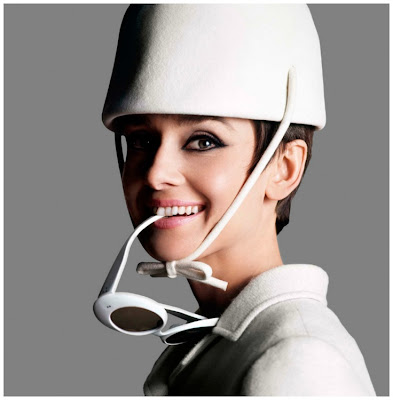 |
| Audrey Hepburn in Courrèges |
The 1960s are my decade. I am obsessed with everything from the 60s -- home interiors to fashion to culture...and on and on. My favorite band is the Beatles. I know my Motown and my beach music. I drove a 1965 Ford Mustang in high school. I love Doris Day and Audrey Hepburn movies from the 60s -- like The Glass Bottom Boat and Charade. And the clothes -- those mod, mod clothes -- make me go weak in the knees.
The best design is almost always the simplest design. There are exceptions to that rule, but not in this case. Mod is about clean, simple geometry and bright (or absence) of color. Crisp white, primary colors, and black are the go-to hues, and the shapes are short and graphic. Bold and quite risque for the time.
One of the creators of ultra-mod fashion was André Courrèges. He was born in France in 1923, and because of his father's wishes, actually trained to be an engineer, rather than the artist he wanted to be. It didn't stick. By 1948, he started working with Cristóbal Balenciaga, advancing to become Balenciaga's first assistant.
 |
| Courrèges, on right |
By 1961, Courrèges was designing under his own name, for his own fashion house. He did in France what Mary Quant did in England -- embraced youth fashion. The times were a-changin', and they capitalized on the freedom of the 1960s. Quant and Courrèges both claim ownership of the mini skirt; hemlines inched up and the brassieres came off. Cut-outs were specifically placed to highlight the body.
His collection for spring 1964 immediately became known as Space Age. In addition to his mini skirts, cutout dresses, and trouser suits (shocking!), he introduced goggle style sunglasses, helmet style hats, and flat boots, reminiscent of astronaut's gear. The silhouette was known as a "moon girl." It's said that:
"His collection featured proportionate, well-cut pants, rigidly constructed clothes with smooth “trapeze,” or trapezoidal, lines, and short skirts, with white midcalf boots and large, dark glasses as accessories. White became his trademark."*
Courrèges’s first official couture collection made its debut in 1965. In 1967, he started his made-to-order custom line, Prototype. His clothing was not necessarily a hit in the couture world. Traditionally, couture buyers were older women, and these styles were definitely for the younger generation. Lower priced retailers began copying his work, making little a-line dresses, vinyl go-go boots, and bug-eyed sunglasses.
Courrèges introduced luxury prêt-a-porter, with his line called Couture Future, at the end of the decade. In the 1970s, he established his first fragrance, Empreinte, as well as a men’s ready-to-wear line. Courrèges' Hyperbole line, started in the early 1980s, hit at a lower price point, in an attempt to grab a more mass-market audience.
In these later years, Courrèges' color palette moved from primary and neutral to acid colors. He also made some glow-in-the-dark fashions. In 1985, he retired and sold his business to the Japanese firm, Itokin. The company is still going, making clothes that carry Courrèges' mod influence.
 |
| Diana Ross in Courrèges |



No comments:
Post a Comment
Note: Only a member of this blog may post a comment.